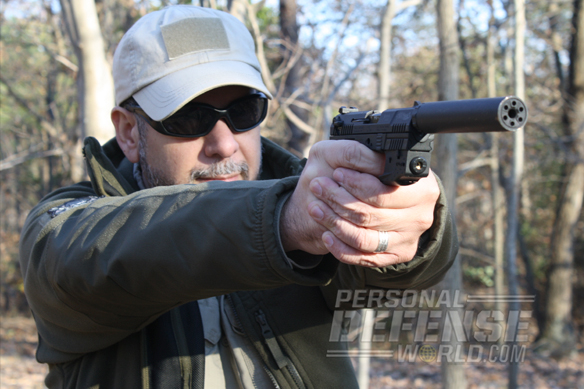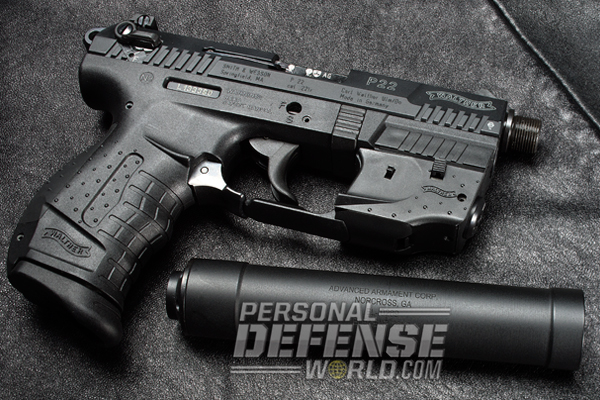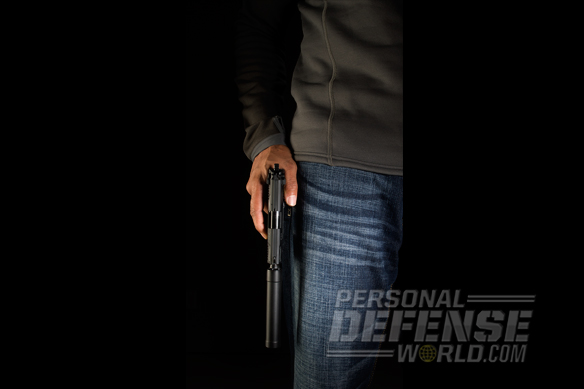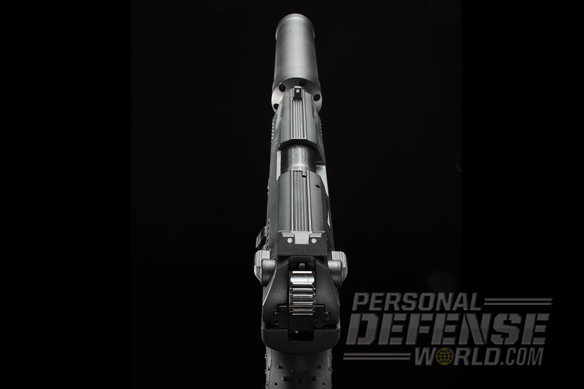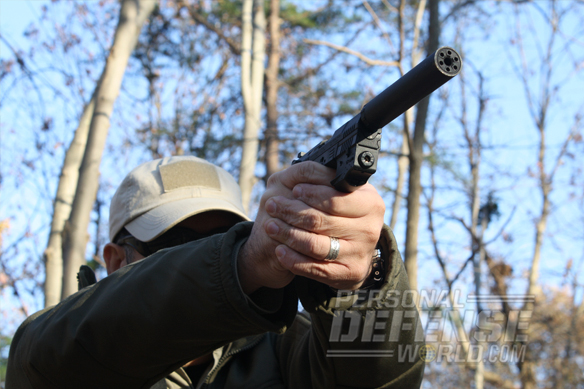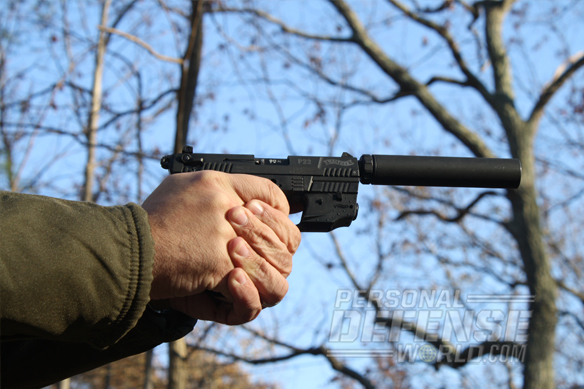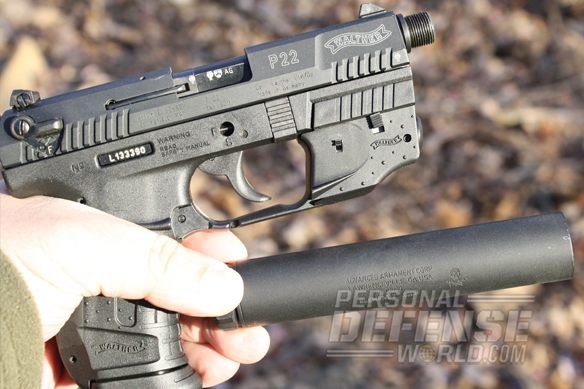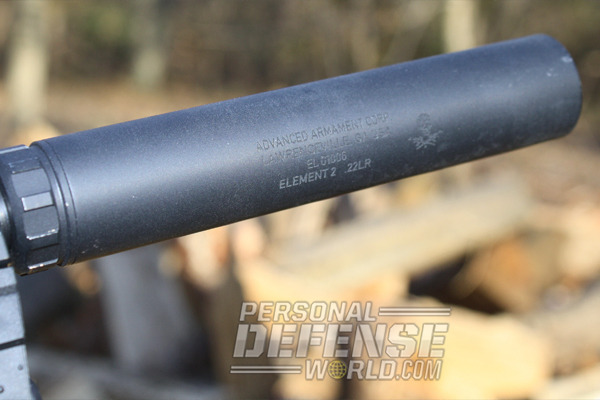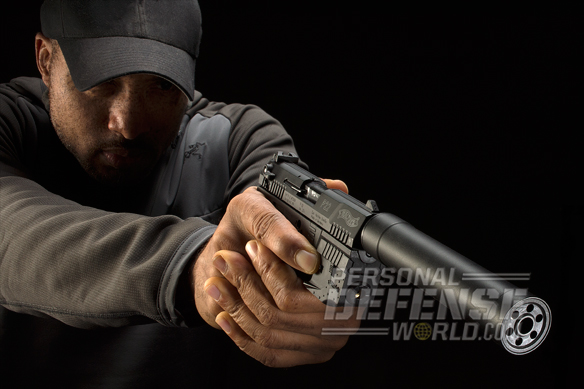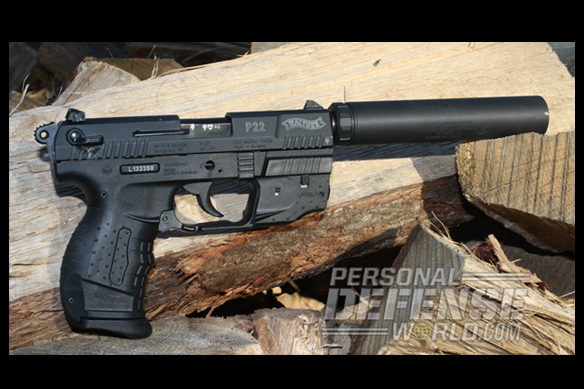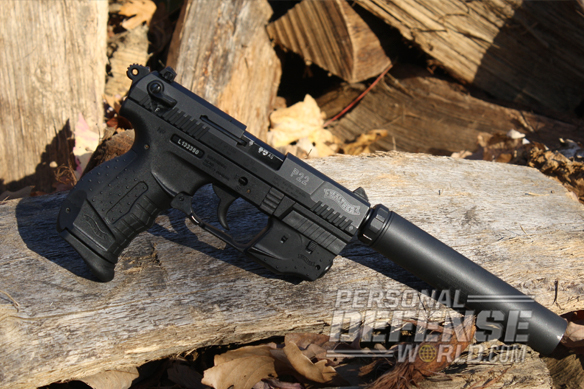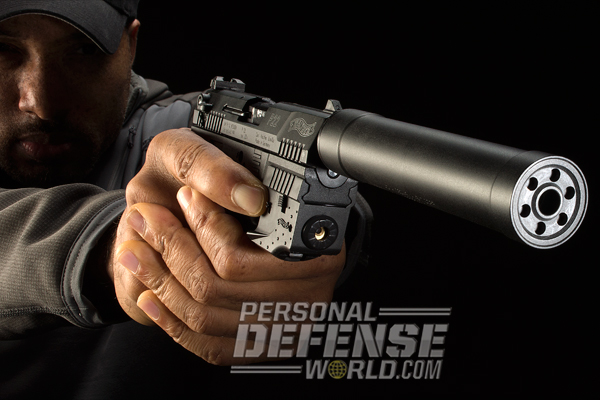The Element 2 suppressor is a sleek, silent system that delivers rapid and accurate shooting!
The suppressed .22 rimfire pistol certainly has an aura of mystery and intrigue about it. It looks and feels like it belongs in the pages of a spy novel in the hands of a secret agent on assignment behind the Iron Curtain and in need of discretion. There is no question that suppressed .22 pistols are cool, but it’s quite wrong to think of them as some sort of assassin’s weapon. The fact is that they are the ideal beginner’s pistol. The .22 Long Rifle (LR) rimfire cartridge is already well established as ideal for first-time shooters because of its low recoil. The cartridge’s availability, low cost, and high fun coefficient also make it the most popular all-around cartridge. Adding a suppressor makes it even better, and a growing number of manufacturers are for this very reason including threaded barrels as a standard option on their .22 pistols.
Advertisement — Continue Reading Below
“I recently took a first-time shooter to the range who was extremely nervous and sensitive to the sound firearms make…The suppressed .22 was a game changer in her instruction.”
ELEMENTS OF SILENCE:
I own a Walther P22 and recently acquired the excellent AAC Element 2 suppressor. Thanks to its titanium construction, the suppressor adds only 4 ounces to the pistol, which keeps it very light and easy to handle. The slight bit of extra weight soaks up some of the already light recoil, and since the extra weight is all at the front it also keeps the muzzle on target with virtually zero climb. This makes shooting fast and staying on target extremely easy. The extra length the Element 2 adds to the front of the pistol—just over 5 inches—also helps emphasize muzzle awareness for beginners and the importance of keeping the pistol pointed in a safe direction. The Element 2 is only an inch in diameter, so it stays very compact, and it has a tough Cerakote black finish and stainless steel baffles for durability and ultimate corrosion resistance. It can be disassembled for cleaning, which is not something you need to do very often, but the .22LR can shoot pretty dirty, so the occasional cleaning is a good idea.
Of course, the main advantage to adding a suppressor is the subsequent reduction in the noise levels associated with shooting. Here the Element 2 is superb: It has a rated sound reduction of 41 decibels (dB). This is quite a bit better than your average hearing protection, which provides between 20 and 33 dBs of noise reduction. A good way to think about noise levels is with various comparisons. Normal conversation is 40 to 60 dBs; at 85 dBs it is possible to sustain hearing damage with continuous noise. A gas-powered chainsaw reaches about 110 dBs, and at 120 dBs hearing damage can occur from a single occurrence. Your ears will hurt at 130 dBs, and a high-powered rifle will produce 160 to 170 dBs. Even the best suppressors will only reduce the sound Level to the comfortable range but not necessarily the safe range.
CLICK HERE to read the next page of Stealthy .22s | Element 2 Suppressor!
Advertisement — Continue Reading Below
The .22LR cartridge is not typically a major noise-maker, and decibel levels unsuppressed can range from 90 to 120 dB depending on a variety of factors such as ammunition and type of firearms used. A 40-dB reduction brings the sound level down to that of normal conversation (not loud barroom conversation). Indeed, when shooting my suppressed P22, I have no need for hearing protection at all. It sounds like you are shooting a CO2-powered pellet gun instead of a firearm. The only other factor to consider in the sound of the suppressed .22LR is the velocity of the bullet. Rimfire ammunition in this caliber can range from standard cartridges that travel at just over 1,100 feet per second (fps) to hyper-velocity rounds that exceed 1,400 fps.
The speed of sound is about 1,140 fps depending on elevation and atmospheric conditions. When a bullet breaks the sound barrier, you get a sonic boom which defeats your sound-suppression intent. As a result, those who want the ultimate in sound suppression will use sub-sonic ammunition. However, in a pistol this isn’t really necessary. The shorter barrel length means that the bullets do not reach their maximum velocity (which is rated using longer rifle barrels). Pretty much all .22LR will shoot subsonic out of a pistol, or about 1,000 fps. I also tested this out using high-velocity and sub-sonic ammunition and could not notice any difference.
Advertisement — Continue Reading Below
HANDS-ON TIME
I recently took a first-time shooter to the range who was extremely nervous and sensitive to the sound firearms make, especially the concussive effect of the muzzle blast going past you with centerfire handguns and rifles. To a long-time shooter, this muzzle blast is unnoticeable unless you are shooting a cannon, but some are more sensitive than others. Despite her trepidation she was very comfortable with the suppressed P22. With very little instruction she was easily able to keep shots on target and gained confidence and skill. This was someone who, when I had previously brought her to the range, had decided she didn’t want to try it. The suppressed .22 was a game changer in her instruction.
In general, suppressors offer a lot of benefits. In low light they preserve night vision by eliminating muzzle flash. The baffles are temporarily trapping the escaping gasses, and any unburned powder that would otherwise exit the barrel and create a muzzle flash is also trapped and burned inside the baffles. These baffles also act as a sort of muzzle brake helping to reduce recoil, and the suppressor itself can improve barrel harmonics, increasing accuracy. The basic suppressor is not exactly new technology. It was originally invented and marketed in 1902 by Hiram Percy Maxim, whose father invented the Maxim Machine Gun. It basically works like a muffler on a car, and even President Theodore Roosevelt used a suppressed Model 1894 lever action .30-30 rifle to keep pests out of his backyard without bothering his neighbors.
CLICK HERE to read the next page of Stealthy .22s | Element 2 Suppressor!
Advertisement — Continue Reading Below
To get one you will need to fill out a bit of paperwork, as suppressors are regulated under the National Firearms Act of 1934. Thirty-nine states currently allow the private ownership of suppressors, and many of them also allow their use for hunting. Once you get Uncle Sam’s OK, make sure to keep a copy of the tax stamp with you whenever you take your suppressor out to shoot so you can prove it is legally registered. There are a lot of quality .22LR suppressors available. The commonality of the threads on the barrels allow the same suppressor to be used on a variety of rimfire pistols and rifles, and most rimfire suppressors will work with .22LR, .17 HMR and .22 Magnum cartridges. AAC maintains a very informative website on suppressors that they call their Silencer University, which provides instruction and a quiz that walks you through all the details.
CLICK HERE for more Firearms Accessories!
Advertisement — Continue Reading Below
CLICK HERE to return to the First Page!
For more information on Suppressors, please visit www.aaccanu.com or call 770-925-9988.
For more on the Walther P22 Handgun, visit: http://www.waltherarms.com/
Advertisement — Continue Reading Below
